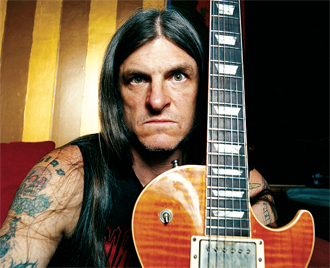Scott "Wino" Weinrich: Hand of Doom

Originally published in Guitar World, April 2009
The doom metal legend talks a bit about his tone and his debut solo album, Punctuated Equilibrium.
"I am damn near 50 years old, and I’ve been playing guitar ever since I was eight,” says Scott “Wino” Weinrich. “I’ve always just figured I was hardwired to play from birth.”
Whether nature or nurture produced his calling, over the past 25 years Wino has defined the modern stoner doom metal sound through his influential work with the Obsessed, Saint Vitus and the Hidden Hand. Now the guitarist’s considerable talent has been showcased on his first-ever solo album, Punctuated Equilibrium (Southern Lord Recordings).
The album’s genesis dates back to the Hidden Hand’s breakup, in 2006. “I still had a bunch of ideas and gear lying around,” Wino says, “so I decided to enlist the talents of Jean-Paul Gaster from Clutch on drums and my good friend John Blank on bass.” Combining dark, sludgy Sabbath-inspired doom, Grand Funk Railroad–style riffage and Wino’s deep soulful vocals, Punctuated Equilibrium shows his signature sound is alive and well.
The development of Wino’s melodic, groove-heavy playing style can be traced back to 1972, when, as a 10-year-old budding guitarist, he saw Black Sabbath perform. “That’s basically what changed my life right there,” he says.
Wino left the concert with a passion for huge, burly riffs and slow tempos, which he put to use in his first band, the Obsessed. “The Obsessed was my first real band during my adolescence and teenage years,” he explains. “That experience allowed me to go on to play with a lot of fun bands, meet really nice people and visit amazing places.”
All the latest guitar news, interviews, lessons, reviews, deals and more, direct to your inbox!
A renowned tone hound, Wino says the foundation of his sound is “a Les Paul guitar with DiMarzio Super Distortion pickups plugged straight into a Sunn Model T amplifier.” To give his tone that extra-special touch, he swaps out the stock Sunn tubes with Svetlana 6550s power tubes and Electro-Harmonix preamp tubes. “That is really the heart of the sound,” he says, “because it’s like a fuzz box in a preamp tube.”
